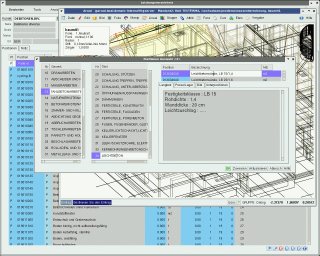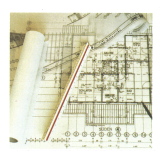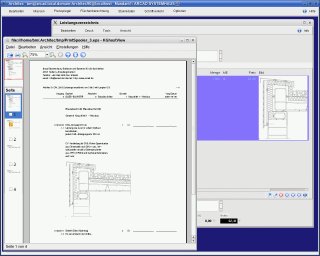LXAVA AVA

In the AVA field of duty the point is to lessen standard calculations from the structural engineer and to assist him with the quick issuing of conclusive and perfect calculations.
Information which you always require every single day in recurrent form is administered by LXAVA as for example telephone numbers or text descriptions for a work to be written out.
An office cannot function without correspondence with builder-owners, entrepreneurs and authorities.
LXAVA offers you an efficient text editing.
Whether you change service items, write a letter or create expertises, the text processing of LXAVA is universal.
Convenient working on a project
The graphical user interface is developed according to international standard which offers you a standardised handling.
Several separated and manageable fields of work provide you only with the possibilities which exactly belong to the procedure which you just edit.
No matter whether position or addresses, you can feed up to four independent texts for every single entry.
All your freely determined additional information can be filed here.
If you must re-enter positions which only differs in details, you simply double and change these.
Due to the possibility of LXAVA to edit two construction projects at the same time on the display you can transmit one or several entries from an already available project straight into a new project.
LXAVA uses the program ARCAD 3D CAD in order to take over comprehensibly the quantity and surface entries which are already defined in the drawing.
Quantity determination
The key to these advantages is the computer-aided quantity determination.
Even without the use of the CAD the amounts are easy and quick collected whereas right from the start the precision of the position level is used, when required they can also be itemized already up to the construction materials (option ordering system).
If the CAD is installed, the generated amounts can automatically be taken over.
Besides, all elements and amounts of the drawings are taken over and checked according to the VOB.
The used texts and positions can optionally be oriented to STLB or to the SIRADOS texts.
However, the dimensions can also be read in the drawings and be entered manually, whereas evaluation groups and commenting remarks are added according on demand.
Besides, the order of the entry plays no role.
In the dialog with the computer the arithmetic statements can at any time be corrected, changed or completed whether taken over manually created, from the graphics or of a model house.
Because the order of the entries is irrelevant for the program, you can go about on demand, e.g. on quantity structure or components.
Every entry contains arbitrarily mixed explaining remarks and arithmetic statement including multistage bracket calculations; the number of the rows or arithmetic operations per position number is not limited.
In addition, a further information can be assigned to the single arithmetic lines which controls the creation of a room book in the background.
The assignment to the crafts or ranges of performance follows automatically, nevertheless, can also be changed manually.
Because LXAVA presents merely proposals, fictive titles can be used to analyze subtotals.
Besides, amounts as well as expenses can be considered.
The entries are finally sorted according to crafts, lots, titles and positions whereas the protocol of the entries is preserved.
The calculated or from the CAD imported amounts can optionally be recorded.
Besides, if requested the required construction materials can also immediately be listed.
The amount protocol shows not only the exact amounts of all positions according to subdivided craft, but offers the exact arithmetic way including explanations for every position.
This amount file of the construction project is preserved and can be coarchived if the project is stored as a house type.
(Option Ordering system)
Later variants can be calculated on this basis even faster whereupon the detailed documentation of the calculation guarantees that the object just remains comprehensible at any time.
For the control and monitoring of the running project this comprehensiveness is an essential relief if, for example, changes should be taken into consideration during the execution of construction work.
Such changes can easily be introduced, their consequences are surveyed quickly.
Costing

Lengths, surface areas, capacities, living spaces, useful areas and circulation spaces can directly be taken from the drawing created with ARCAD.
If requested all masses and indexes are automatically calculated like lengths, surfaces and volumes and are directly provided to the LXAVA AVA for further processing.
With this concept expensive working hours are not only saved in a considerable measure, but it also eliminates most malfunction sources regarding the transfer from the drawing to the bill of quantities.
The speed at which this evaluation can be carried out with sovereign precision is an invaluable help with quick evaluation of alternatives in the preliminary planning.
Many new possibilities also result from the quickness and accuracy regarding the consultation of potential buyers with which variations can be outlined and their consequences be in particular analyzed concerning the cost aspect.
The conventionally inexact cost estimate can be ignored, because LXAVA carries out a substantially more exact cost accounting with the same expenditure of time.
This costing arises from an expansion of the market-driven single prices which are automatically maintained with every price comparison list and with every placing.
To be able to offer a price guarantee which can also still be maintained with short-term fluctuations of the market prices, the projection can also be supported on the middle prices which were likewise received by the last edited processes.
The third possibility is the use of internal calculated prices which must usually be maintained manually.
LXAVA is also aimed to support functions of the building contractors, too.
If this possibility is used, the calculation prices from the building material prices are independently calculated taking into account the wage hours and the respective share in profits by the program.
(Option Ordering system)
This high accuracy at a very early time of the planning simplifies the cost-benefit analysis and clearly increases the reliability of its results.
The quantity survey calculation taken over from the drawing, incidentally printed out a finished building application, supports the cost-benefit calculation.
The detailed and exact documentation of the costing allowes a suitable formulation of the contracts with the co-operating construction enterprises, the risk of cost increases can be minimized.
On the other hand dependable figures can be presented in a very early stage to the builder-owner or his bank, so that payment plans and financial budgets remain firm.
Bid proposal management

An offer with a reliable price can be prepared to the potential builder-owner in the shortest time from an own repertoire of sophisticated text blocks for the specifications.
Besides, the texts are automatically selected from the mass calculation if addressed positions should be described there.
The suitable text is then added to the specifications at the selected place.
These texts are furnished with variables whose contents, not until the description is formulated, are to be appointed to the project, for instance colour of the carpeted floor, execution of the door handles, or similar, so that a customer can be assured of the equipment of his choice as soon as possible.
An quotation is especially comfortably to be written if it can revert to an archived show house.
The directory of the quotation texts for this house is likewise saved.
The printout can immediately be carried out after the equipment details are arranged.
However, the own contributions can also be fixed before which the prospective buyer wants himself to deliver in the wage or material range.
At the same time all drawings and the complete mass calculation have been taken over in all elaborateness, as described above, from the archive into the new constructed project.
If the show house is varied in its amounts or a totally new object is laid out, the quotation texts serve as a basis for the order acknowledgement. No prices are listed, except for the all round price which is shown on the front page.
The detailed specifications for the customer can be complemented with free texts.
LXAVA separates the technical texts for the call for tenders from the describing texts for the builder-owner.
Draft alternatives
The optimum transparency of the protocols in connection with its easy and quick use also permits to check draft alternatives very thoroughly and to compare so that decisions can be concluded more distinctly.
Another important advantage consists in tendering projects with the exact amounts and in bringing in correction wishes of the building contractors before the contract placing.
Without additional expenses the quantity determination of LXAVA offers, in addition, the exact calculation of the building costs broken down to positions with unit and all round price, craft prices and all round price of the complete construction project as a sum of the craft prices.
(Option Ordering system)
The price protocols can optionally be oriented on the company-specific calculation prices of the positions or on the company-related craft prices of the last placing. The market-driven middle prices of the last call for tenders can in addition be used.
All these prices are automatically maintained so far as possible.
Call for tenders
The detailed estimate is automatically arranged from the checked quantity determination.
Sophisticated texts can be created and be retrieved when required per position with LXAVA.
The descriptions of the performances, the preliminary remarks about VOB regulations to be applied or DIN norms and other remarks relevant to contract are saved as boilerplates in the central data base and are administered position-wise.
The assumed detailed estimate can still now be corrected with regard to the calculated total quantities, be complemented with other performances and be complemented with the required remarks towards the capacity ranges up to the execution of the call for tenders.
However, the same result can also manually be achieved by direct entry of key numbers and amounts if the quantity determination should not be used.
LXAVA commands preliminary remarks, alternative, contingency as well as supplementary items up to the price comparison list.
Position texts can be edited regardless of the running or planned projects.
The control of the texts is considerably simplified and accelerated. The often time-consuming and expensive typing errors are eliminated in the approach.
Well worked out texts are available on call.
Errors in the call for tenders do not appear in the everyday life at all, because they are to be avoided without noteworthy efforts.
Supplements and the with it associated work concerning organisation and execution finally become for most part redundant.
Because remarks and preliminary notes are also addressed, they are associated to the correct crafts in the detailed estimate.
A short protocol of the directory offers a quick and paper-saving overview and allowes a completeness check before the actual printout.
In order to printout a the call for tenders the system LXAVA sorts the detailed estimate which is already divided into craft, titles and positions, furtheron according to entrepreneurs or entrepreneur's groups.
The construction enterprises are likewise recorded in the data base and are divided into groups like branches of trade or regions.
Hence, the system LXAVA can write out the important services for any considered entrepreneur and coprint immediately the address label.
(Option Ordering system)
You can freely select the printing form.
The blank form provides the entrepreneur to enter either single price and all round price per position, or also to divide the single price into material and wage price.
The preparation of a placing absorbs a lot of time in the traditionally controlled office of architect's.
Besides, the skill of the planner is only demanded to a tiny fraction of the jobs resulting on this occasion.
LXAVA relieves the planner of time-consuming execution works in the text field and increases the efficiency of his activity.
The experiences of planning offices which already work with LXAVA for some time show a time saving of 60-70 percent.
An average freely planned two family house is placed with LXAVA after one day if a certified employee co-operates with a clerk after determination of the basis and conclusion of the planning preparations.
On this occasion, the time saving regarding the plotting of execution drawings or detail drawings etc. is not taken into consideration at all.
Check on quotations
If one uses the possibility given by LXAVA to write out the exact amounts, the offer audit diminshes to checking the all round prices.
While recording the offers of the entrepreneurs in the price comparison list the entered unit prices are automatically multiplied position-wise with the associated amounts and thus the all round price is calculated per position.
Tthe all round prices can also be entered vice versa. The unit prices are then calculated by the program and thus a conclusion about the allocated amounts is won.
If requested material and wage interest can also be entered separately. The unit and all round price of the positions are calculated by the program.
(Option Ordering system)
If all entries of a bidder are recorded, the whole bid sum is displayed.
These can immediately be compared to the entry of the bidder.
Type errors can immediately be corrected.
The quotations can again be checked with a protocol after they are registered.
Located errors can immediately be corrected on the spot.
The entered data are available for the evaluation of the quotations.
Price comparison list
The quotations can be entered during the whole term of the time limit, so that the price comparison list file is always up-to-date.
It is possible to already print out the price comparison list even if all quotations have not come in yet.
The completeness of later overviews is thereby not touched, because the entries remain saved up to final placing.
The program LXAVA prints out the price comparison list of a craft, lot and title in such a way that the single bidders are listed parallel and the positions one below the other.
The most favorable bidder is alternatively displayed per position, title, lot, craft and project.
Finally the program creates the title and the craft overview and delivers a comparison of the craft prices as well as the respectively most favorable bidders.
The bids are compared on a value basis as well as percental for every bidder and any range.
The most favorable bidder is compared with the most expensive bidder on the basis of the remaining bidders.
Price variances are therefore to be recognised at a glance, also the measure of the varance is shown.
The exact and detailed representation of the quotations, as it results from the overhaul quantity determination, lets the recorded market become clear for you in the price comparison list.
The price comparison list of LXAVA offers the optimum basis for negotiations with the companies which are shortlisted.
Allocation{Placing}
LXAVA suggests for the placing the respectively most favorable bidder per craft.
If another bidder is selected, the program immediately displays his latest quotation prices.
With the entry of a final discount the irrevocable placing price of the craft is fixed.
After the entrepreneur was appointed who should receive the sale, the order acknowledgement (the placing) must be written.
On this occasion, the technical specifications for the contract must finally be written.
LXAVA helps here by reffering to the blank form as it has been created in the call for tenders.
The prices are combined with the detailed estimate which was used for the call for tenders, and the detailed wording of a contract can thus be printed.
The subtotals are thereby listed, the negotiated discount is shown and deducted from the total sum.
This clean and exact copy of the contract presents a sound basis of the collaboration and is created without particular efforts.
The placing price will automatically counted back on the addressed positions. The placing prices as well as the middle prices resulting from the price comparison list are entered into the master data of the positions where they are ready as basic values of the next cost estimate.
At the same time the placing price is taken over as a cost estimate in the building cost monitoring subdivided after crafts.
The placing prices of the crafts serve there as a basis for comparison for the automatic cost monitoring and payment control.
When all crafts of a construction project are appointed, this object can be archived as a model house.
All drawings and plans, the entire mass protocol as well as the placing prices of all addressed performances are thereby documented.
This showhouse is then available for an even quicker, exact and market-driven quotation.
Construction accounting
The bill of quantities calculation and the usual final costing become easier by application of the program LXAVA and its exact and sophisticated quantity determination and the constant availability of market-driven prices.
The estimated costs which were automatically entered with the placing of the crafts serve within the monitoring of the progress of the construction work.
As a frame of reference.
At it the produced partial performances and charged advance payments can be checked and be released.
On the other hand the payments of the builder-owner can be compared with the established costs and thus the financial burden of all involved parties hereto appropriately prorated.
Changes during the construction time, for example, personal contributions or supplement wishes of the builder-owner, can also easily be taken into consideration and can immediately be introduced in the running object.
If the ordering system is also carried out with LXAVA, the costs are automatically added at a time with the order of building material to already established costs of the relevant crafts (option Ordering system)
Construction documentation
Except for the mentioned ranges of the word processing LXAVA also supports the editing of free compositions as for example notices of defects, minutes of the meeting, letters and other more.
Besides, standard texts are saved and can be retrieved when required and be modified.
The involved amount of work is substantially lower with this kind of procedure than at the traditional typing pool, not to mention the consumption of paper, because the letters are created, checked and corrected on the display and only then printed.
Addressing the letters or rather the printing of the labels is also considerably simplified.
In addition, all once recorded addresses can be selected for newsletters according to different criteria, for example, the addresses of all building contractors of a sector and region or of all customers who were attended in a certain period of time.
All letters are archived while printing, whereas all relevant entries are filed, too.
The texts are sorted in particular if requested after construction project, section, company and period of time, a text can specifically be searched with any combination of these entries.
It can be found again after without complicated scrolling simply by inquiry the letter which was sent last to a certain address, or it can check the correspondence of a selected period of time.
With LXAVA no letter can be overlooked or wrongly be filed which is another advantage.
Reliability of the contracts
Beside the effect of the rationalisation another aspect is the growth in security for the planner.
LXAVA allows to operate very fast with exact values. It eases the checking and correction as well as the quick and exact evaluation of alternatives for comparative purposes.
This enables on the other hand to calculate accurately more projects in less time, whereas risks for planners and builder-owner decrease and an increase in the competitiveness and efficiency of the office.
Especially for small offices some partial performances become only with LXAVA meaningful which were not rendered up to now often for time or cost reasons or only very limited.

 BACK
BACK PRINT
PRINT BOOKMARK
BOOKMARK ABOVE
ABOVE